Critical Appraisal: Evaluation of Nutrition Intervention RCT
VerifiedAdded on 2022/11/14
|9
|2204
|455
Report
AI Summary
This report presents a critical appraisal of a randomized controlled trial (RCT) evaluating the effects of nutrition intervention on healing of pressure ulcers and nutritional states. The appraisal utilizes the JBI Critical Appraisal Checklist for Randomized Controlled Trials, assessing key aspects such as randomization, allocation concealment, blinding, and statistical analysis. The report examines the study by Ohura et al. (2011), focusing on its strengths and weaknesses in terms of study design, potential biases, and the reliability of the results. The analysis critically evaluates each checklist item, providing detailed explanations and justifications for the assessments. The report concludes with an overall appraisal, highlighting the trial's limitations, such as lack of blinding and allocation concealment, and suggesting areas for improvement in future research. The study participants were tube-fed patients with stage III-IV pressure ulcers, and the intervention involved a nutrition intervention. The report meticulously evaluates the study's methodology and identifies potential sources of bias, providing a comprehensive assessment of the RCT's validity and reliability. The report also provides references to support the evaluation of the RCT.

Running head: CRITICAL APPRAISAL
Nursing
Name of the Student
Name of the University
Author Note
Nursing
Name of the Student
Name of the University
Author Note
Paraphrase This Document
Need a fresh take? Get an instant paraphrase of this document with our AI Paraphraser
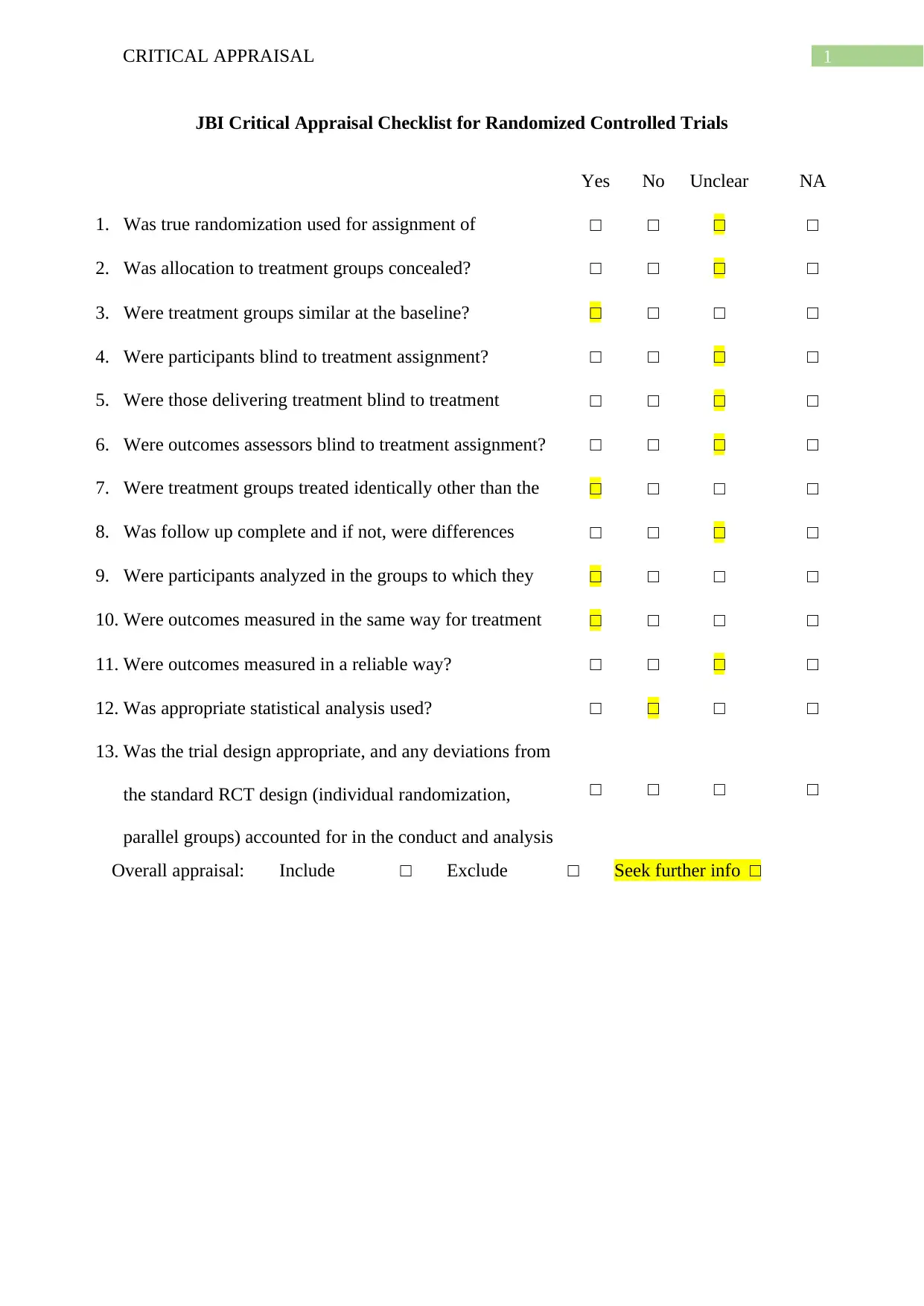
1CRITICAL APPRAISAL
JBI Critical Appraisal Checklist for Randomized Controlled Trials
Yes No Unclear NA
1. Was true randomization used for assignment of
participants to treatment groups?
□ □ □ □
2. Was allocation to treatment groups concealed? □ □ □ □
3. Were treatment groups similar at the baseline? □ □ □ □
4. Were participants blind to treatment assignment? □ □ □ □
5. Were those delivering treatment blind to treatment
assignment?
□ □ □ □
6. Were outcomes assessors blind to treatment assignment? □ □ □ □
7. Were treatment groups treated identically other than the
intervention of interest?
□ □ □ □
8. Was follow up complete and if not, were differences
between groups in terms of their follow up adequately
□ □ □ □
9. Were participants analyzed in the groups to which they
were randomized?
□ □ □ □
10. Were outcomes measured in the same way for treatment
groups?
□ □ □ □
11. Were outcomes measured in a reliable way? □ □ □ □
12. Was appropriate statistical analysis used? □ □ □ □
13. Was the trial design appropriate, and any deviations from
the standard RCT design (individual randomization,
parallel groups) accounted for in the conduct and analysis
of the trial?
□ □ □ □
Overall appraisal: Include □ Exclude □ Seek further info □
JBI Critical Appraisal Checklist for Randomized Controlled Trials
Yes No Unclear NA
1. Was true randomization used for assignment of
participants to treatment groups?
□ □ □ □
2. Was allocation to treatment groups concealed? □ □ □ □
3. Were treatment groups similar at the baseline? □ □ □ □
4. Were participants blind to treatment assignment? □ □ □ □
5. Were those delivering treatment blind to treatment
assignment?
□ □ □ □
6. Were outcomes assessors blind to treatment assignment? □ □ □ □
7. Were treatment groups treated identically other than the
intervention of interest?
□ □ □ □
8. Was follow up complete and if not, were differences
between groups in terms of their follow up adequately
□ □ □ □
9. Were participants analyzed in the groups to which they
were randomized?
□ □ □ □
10. Were outcomes measured in the same way for treatment
groups?
□ □ □ □
11. Were outcomes measured in a reliable way? □ □ □ □
12. Was appropriate statistical analysis used? □ □ □ □
13. Was the trial design appropriate, and any deviations from
the standard RCT design (individual randomization,
parallel groups) accounted for in the conduct and analysis
of the trial?
□ □ □ □
Overall appraisal: Include □ Exclude □ Seek further info □
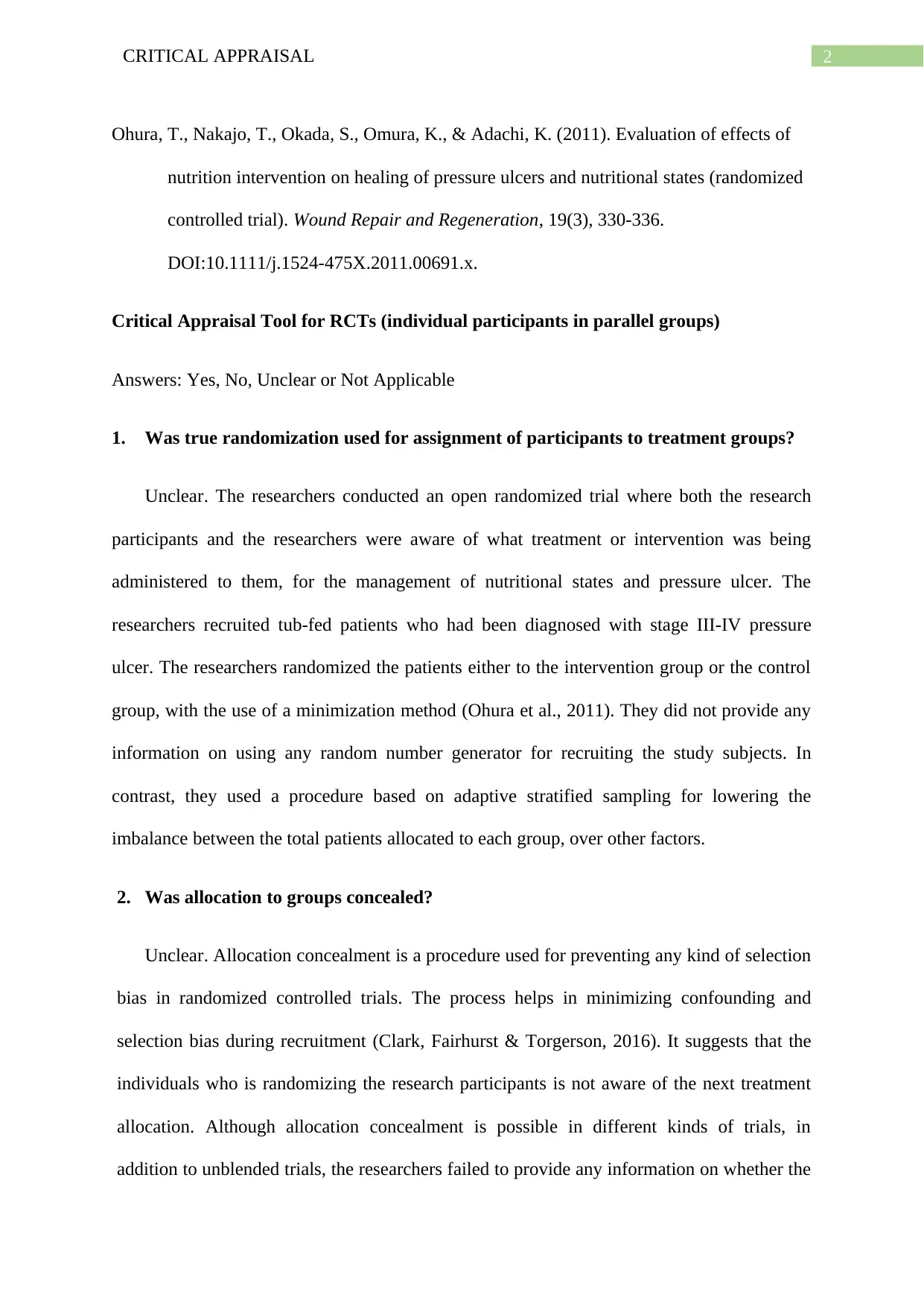
2CRITICAL APPRAISAL
Ohura, T., Nakajo, T., Okada, S., Omura, K., & Adachi, K. (2011). Evaluation of effects of
nutrition intervention on healing of pressure ulcers and nutritional states (randomized
controlled trial). Wound Repair and Regeneration, 19(3), 330-336.
DOI:10.1111/j.1524-475X.2011.00691.x.
Critical Appraisal Tool for RCTs (individual participants in parallel groups)
Answers: Yes, No, Unclear or Not Applicable
1. Was true randomization used for assignment of participants to treatment groups?
Unclear. The researchers conducted an open randomized trial where both the research
participants and the researchers were aware of what treatment or intervention was being
administered to them, for the management of nutritional states and pressure ulcer. The
researchers recruited tub-fed patients who had been diagnosed with stage III-IV pressure
ulcer. The researchers randomized the patients either to the intervention group or the control
group, with the use of a minimization method (Ohura et al., 2011). They did not provide any
information on using any random number generator for recruiting the study subjects. In
contrast, they used a procedure based on adaptive stratified sampling for lowering the
imbalance between the total patients allocated to each group, over other factors.
2. Was allocation to groups concealed?
Unclear. Allocation concealment is a procedure used for preventing any kind of selection
bias in randomized controlled trials. The process helps in minimizing confounding and
selection bias during recruitment (Clark, Fairhurst & Torgerson, 2016). It suggests that the
individuals who is randomizing the research participants is not aware of the next treatment
allocation. Although allocation concealment is possible in different kinds of trials, in
addition to unblended trials, the researchers failed to provide any information on whether the
Ohura, T., Nakajo, T., Okada, S., Omura, K., & Adachi, K. (2011). Evaluation of effects of
nutrition intervention on healing of pressure ulcers and nutritional states (randomized
controlled trial). Wound Repair and Regeneration, 19(3), 330-336.
DOI:10.1111/j.1524-475X.2011.00691.x.
Critical Appraisal Tool for RCTs (individual participants in parallel groups)
Answers: Yes, No, Unclear or Not Applicable
1. Was true randomization used for assignment of participants to treatment groups?
Unclear. The researchers conducted an open randomized trial where both the research
participants and the researchers were aware of what treatment or intervention was being
administered to them, for the management of nutritional states and pressure ulcer. The
researchers recruited tub-fed patients who had been diagnosed with stage III-IV pressure
ulcer. The researchers randomized the patients either to the intervention group or the control
group, with the use of a minimization method (Ohura et al., 2011). They did not provide any
information on using any random number generator for recruiting the study subjects. In
contrast, they used a procedure based on adaptive stratified sampling for lowering the
imbalance between the total patients allocated to each group, over other factors.
2. Was allocation to groups concealed?
Unclear. Allocation concealment is a procedure used for preventing any kind of selection
bias in randomized controlled trials. The process helps in minimizing confounding and
selection bias during recruitment (Clark, Fairhurst & Torgerson, 2016). It suggests that the
individuals who is randomizing the research participants is not aware of the next treatment
allocation. Although allocation concealment is possible in different kinds of trials, in
addition to unblended trials, the researchers failed to provide any information on whether the
⊘ This is a preview!⊘
Do you want full access?
Subscribe today to unlock all pages.

Trusted by 1+ million students worldwide
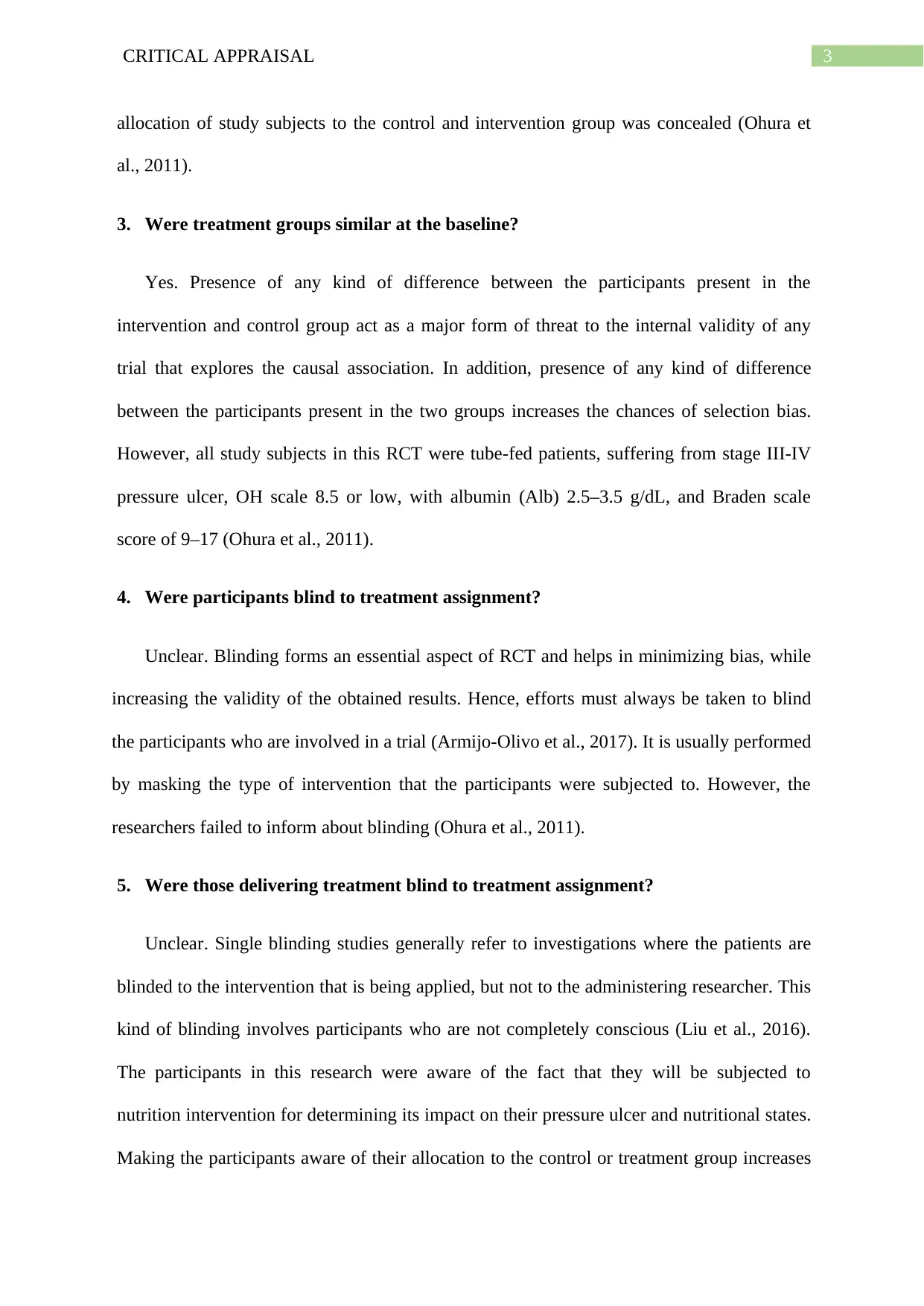
3CRITICAL APPRAISAL
allocation of study subjects to the control and intervention group was concealed (Ohura et
al., 2011).
3. Were treatment groups similar at the baseline?
Yes. Presence of any kind of difference between the participants present in the
intervention and control group act as a major form of threat to the internal validity of any
trial that explores the causal association. In addition, presence of any kind of difference
between the participants present in the two groups increases the chances of selection bias.
However, all study subjects in this RCT were tube-fed patients, suffering from stage III-IV
pressure ulcer, OH scale 8.5 or low, with albumin (Alb) 2.5–3.5 g/dL, and Braden scale
score of 9–17 (Ohura et al., 2011).
4. Were participants blind to treatment assignment?
Unclear. Blinding forms an essential aspect of RCT and helps in minimizing bias, while
increasing the validity of the obtained results. Hence, efforts must always be taken to blind
the participants who are involved in a trial (Armijo-Olivo et al., 2017). It is usually performed
by masking the type of intervention that the participants were subjected to. However, the
researchers failed to inform about blinding (Ohura et al., 2011).
5. Were those delivering treatment blind to treatment assignment?
Unclear. Single blinding studies generally refer to investigations where the patients are
blinded to the intervention that is being applied, but not to the administering researcher. This
kind of blinding involves participants who are not completely conscious (Liu et al., 2016).
The participants in this research were aware of the fact that they will be subjected to
nutrition intervention for determining its impact on their pressure ulcer and nutritional states.
Making the participants aware of their allocation to the control or treatment group increases
allocation of study subjects to the control and intervention group was concealed (Ohura et
al., 2011).
3. Were treatment groups similar at the baseline?
Yes. Presence of any kind of difference between the participants present in the
intervention and control group act as a major form of threat to the internal validity of any
trial that explores the causal association. In addition, presence of any kind of difference
between the participants present in the two groups increases the chances of selection bias.
However, all study subjects in this RCT were tube-fed patients, suffering from stage III-IV
pressure ulcer, OH scale 8.5 or low, with albumin (Alb) 2.5–3.5 g/dL, and Braden scale
score of 9–17 (Ohura et al., 2011).
4. Were participants blind to treatment assignment?
Unclear. Blinding forms an essential aspect of RCT and helps in minimizing bias, while
increasing the validity of the obtained results. Hence, efforts must always be taken to blind
the participants who are involved in a trial (Armijo-Olivo et al., 2017). It is usually performed
by masking the type of intervention that the participants were subjected to. However, the
researchers failed to inform about blinding (Ohura et al., 2011).
5. Were those delivering treatment blind to treatment assignment?
Unclear. Single blinding studies generally refer to investigations where the patients are
blinded to the intervention that is being applied, but not to the administering researcher. This
kind of blinding involves participants who are not completely conscious (Liu et al., 2016).
The participants in this research were aware of the fact that they will be subjected to
nutrition intervention for determining its impact on their pressure ulcer and nutritional states.
Making the participants aware of their allocation to the control or treatment group increases
Paraphrase This Document
Need a fresh take? Get an instant paraphrase of this document with our AI Paraphraser

4CRITICAL APPRAISAL
the risk of their acting differently to the intervention, thus distorting the results. The
researchers also failed to provide adequate information whether the trial was a single blinded
study or not (Ohura et al., 2011).
6. Were outcomes assessors blind to treatment assignment?
Unclear. Blinding can be imposed on several participants, including the researchers and
technicians. If researchers who are in charge of delivering the intervention are aware of the
allocation of the participant to the control or the treatment group, there often arises the risk of
behaving in a different manner. Furthermore, blinding of outcome assessors also
encompasses steps that prevent them to know which group is currently being treated or
subjected to a particular intervention. There is substantial evidence that presence of an
unblended research assessment leads to bias in estimation of the impact of certain
intervention (Armijo-Olivo et al., 2017). The researchers did not provide any information
whether the outcome assessors were blind to assignment of the nutrition treatment (Ohura et
al., 2011).
7. Were treatment groups treated identically other than the intervention of interest?
Yes. With the aim of developing a correlation between the cause and the effect, there
must not be present any kind of selection bias, apart from the cause that is being manipulated
or changed. The research participants recruited to the two groups were treated in an equal
manner, regardless of their allocation. Those in the control group were subjected to similar
amount of calories, prior to their participation in the investigation. The exposure to the
treatment occurred simultaneously between the two groups. All patients were administered a
feeding formula, Racols (EN Otsuka Pharmaceutical Co., Ltd., Iwate, Japan). The only
difference was in the total calorie intake between the control and the treatment group, thus
preventing any bias (Ohura et al., 2011).
the risk of their acting differently to the intervention, thus distorting the results. The
researchers also failed to provide adequate information whether the trial was a single blinded
study or not (Ohura et al., 2011).
6. Were outcomes assessors blind to treatment assignment?
Unclear. Blinding can be imposed on several participants, including the researchers and
technicians. If researchers who are in charge of delivering the intervention are aware of the
allocation of the participant to the control or the treatment group, there often arises the risk of
behaving in a different manner. Furthermore, blinding of outcome assessors also
encompasses steps that prevent them to know which group is currently being treated or
subjected to a particular intervention. There is substantial evidence that presence of an
unblended research assessment leads to bias in estimation of the impact of certain
intervention (Armijo-Olivo et al., 2017). The researchers did not provide any information
whether the outcome assessors were blind to assignment of the nutrition treatment (Ohura et
al., 2011).
7. Were treatment groups treated identically other than the intervention of interest?
Yes. With the aim of developing a correlation between the cause and the effect, there
must not be present any kind of selection bias, apart from the cause that is being manipulated
or changed. The research participants recruited to the two groups were treated in an equal
manner, regardless of their allocation. Those in the control group were subjected to similar
amount of calories, prior to their participation in the investigation. The exposure to the
treatment occurred simultaneously between the two groups. All patients were administered a
feeding formula, Racols (EN Otsuka Pharmaceutical Co., Ltd., Iwate, Japan). The only
difference was in the total calorie intake between the control and the treatment group, thus
preventing any bias (Ohura et al., 2011).
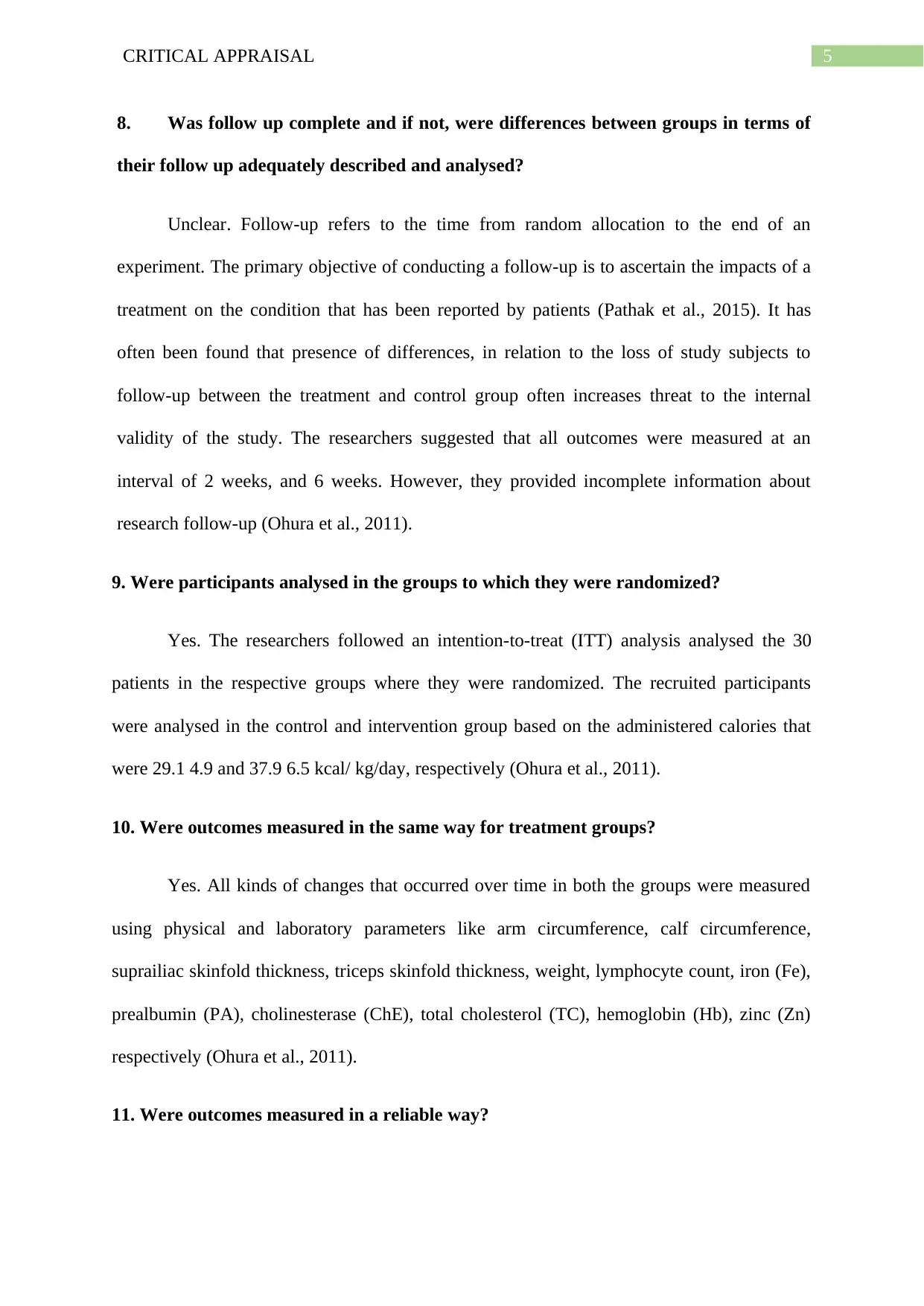
5CRITICAL APPRAISAL
8. Was follow up complete and if not, were differences between groups in terms of
their follow up adequately described and analysed?
Unclear. Follow-up refers to the time from random allocation to the end of an
experiment. The primary objective of conducting a follow-up is to ascertain the impacts of a
treatment on the condition that has been reported by patients (Pathak et al., 2015). It has
often been found that presence of differences, in relation to the loss of study subjects to
follow-up between the treatment and control group often increases threat to the internal
validity of the study. The researchers suggested that all outcomes were measured at an
interval of 2 weeks, and 6 weeks. However, they provided incomplete information about
research follow-up (Ohura et al., 2011).
9. Were participants analysed in the groups to which they were randomized?
Yes. The researchers followed an intention-to-treat (ITT) analysis analysed the 30
patients in the respective groups where they were randomized. The recruited participants
were analysed in the control and intervention group based on the administered calories that
were 29.1 4.9 and 37.9 6.5 kcal/ kg/day, respectively (Ohura et al., 2011).
10. Were outcomes measured in the same way for treatment groups?
Yes. All kinds of changes that occurred over time in both the groups were measured
using physical and laboratory parameters like arm circumference, calf circumference,
suprailiac skinfold thickness, triceps skinfold thickness, weight, lymphocyte count, iron (Fe),
prealbumin (PA), cholinesterase (ChE), total cholesterol (TC), hemoglobin (Hb), zinc (Zn)
respectively (Ohura et al., 2011).
11. Were outcomes measured in a reliable way?
8. Was follow up complete and if not, were differences between groups in terms of
their follow up adequately described and analysed?
Unclear. Follow-up refers to the time from random allocation to the end of an
experiment. The primary objective of conducting a follow-up is to ascertain the impacts of a
treatment on the condition that has been reported by patients (Pathak et al., 2015). It has
often been found that presence of differences, in relation to the loss of study subjects to
follow-up between the treatment and control group often increases threat to the internal
validity of the study. The researchers suggested that all outcomes were measured at an
interval of 2 weeks, and 6 weeks. However, they provided incomplete information about
research follow-up (Ohura et al., 2011).
9. Were participants analysed in the groups to which they were randomized?
Yes. The researchers followed an intention-to-treat (ITT) analysis analysed the 30
patients in the respective groups where they were randomized. The recruited participants
were analysed in the control and intervention group based on the administered calories that
were 29.1 4.9 and 37.9 6.5 kcal/ kg/day, respectively (Ohura et al., 2011).
10. Were outcomes measured in the same way for treatment groups?
Yes. All kinds of changes that occurred over time in both the groups were measured
using physical and laboratory parameters like arm circumference, calf circumference,
suprailiac skinfold thickness, triceps skinfold thickness, weight, lymphocyte count, iron (Fe),
prealbumin (PA), cholinesterase (ChE), total cholesterol (TC), hemoglobin (Hb), zinc (Zn)
respectively (Ohura et al., 2011).
11. Were outcomes measured in a reliable way?
⊘ This is a preview!⊘
Do you want full access?
Subscribe today to unlock all pages.

Trusted by 1+ million students worldwide

6CRITICAL APPRAISAL
Unclear. The DESIGN (Japanese evaluation tool of pressure ulcers: Depth, Exudate,
Size, Inflammation/Infection, Granulation tissue, Necrotic tissue and Undermining), OH
scale and Braden Scale was used for determining the changes that occurred amid the
participants in their pressure ulcers (Sanada, 2018). However, the researchers failed to
provide information on the training and number of raters, and their inter-rater reliability
(Ohura et al., 2011).
12. Was appropriate statistical analysis used?
Yes. Violating assumptions for statistical measurements and poor statistical measure
are found to weaken the validity of the research findings. The researchers performed
statistical analysis using SPSS 16.0J for Windows. They also calculated descriptive statistics
for determining the differences in characteristics between the research participants (Ohura et
al., 2011).
13. Was the trial design appropriate for the topic, and any deviations from the standard
RCT design accounted for in the conduct and analysis?
No. Lack of blinding, and allocation concealment reduced reliability of the RCT
findings. Hence, it was essential to conduct a crossover trial where the pressure ulcer patients
would be subjected to a series of diverse treatments (Hurkens et al., 2016). This would have
helped in determining the intervention that is most effective in reducing the impact of
pressure ulcer among patients.
Unclear. The DESIGN (Japanese evaluation tool of pressure ulcers: Depth, Exudate,
Size, Inflammation/Infection, Granulation tissue, Necrotic tissue and Undermining), OH
scale and Braden Scale was used for determining the changes that occurred amid the
participants in their pressure ulcers (Sanada, 2018). However, the researchers failed to
provide information on the training and number of raters, and their inter-rater reliability
(Ohura et al., 2011).
12. Was appropriate statistical analysis used?
Yes. Violating assumptions for statistical measurements and poor statistical measure
are found to weaken the validity of the research findings. The researchers performed
statistical analysis using SPSS 16.0J for Windows. They also calculated descriptive statistics
for determining the differences in characteristics between the research participants (Ohura et
al., 2011).
13. Was the trial design appropriate for the topic, and any deviations from the standard
RCT design accounted for in the conduct and analysis?
No. Lack of blinding, and allocation concealment reduced reliability of the RCT
findings. Hence, it was essential to conduct a crossover trial where the pressure ulcer patients
would be subjected to a series of diverse treatments (Hurkens et al., 2016). This would have
helped in determining the intervention that is most effective in reducing the impact of
pressure ulcer among patients.
Paraphrase This Document
Need a fresh take? Get an instant paraphrase of this document with our AI Paraphraser
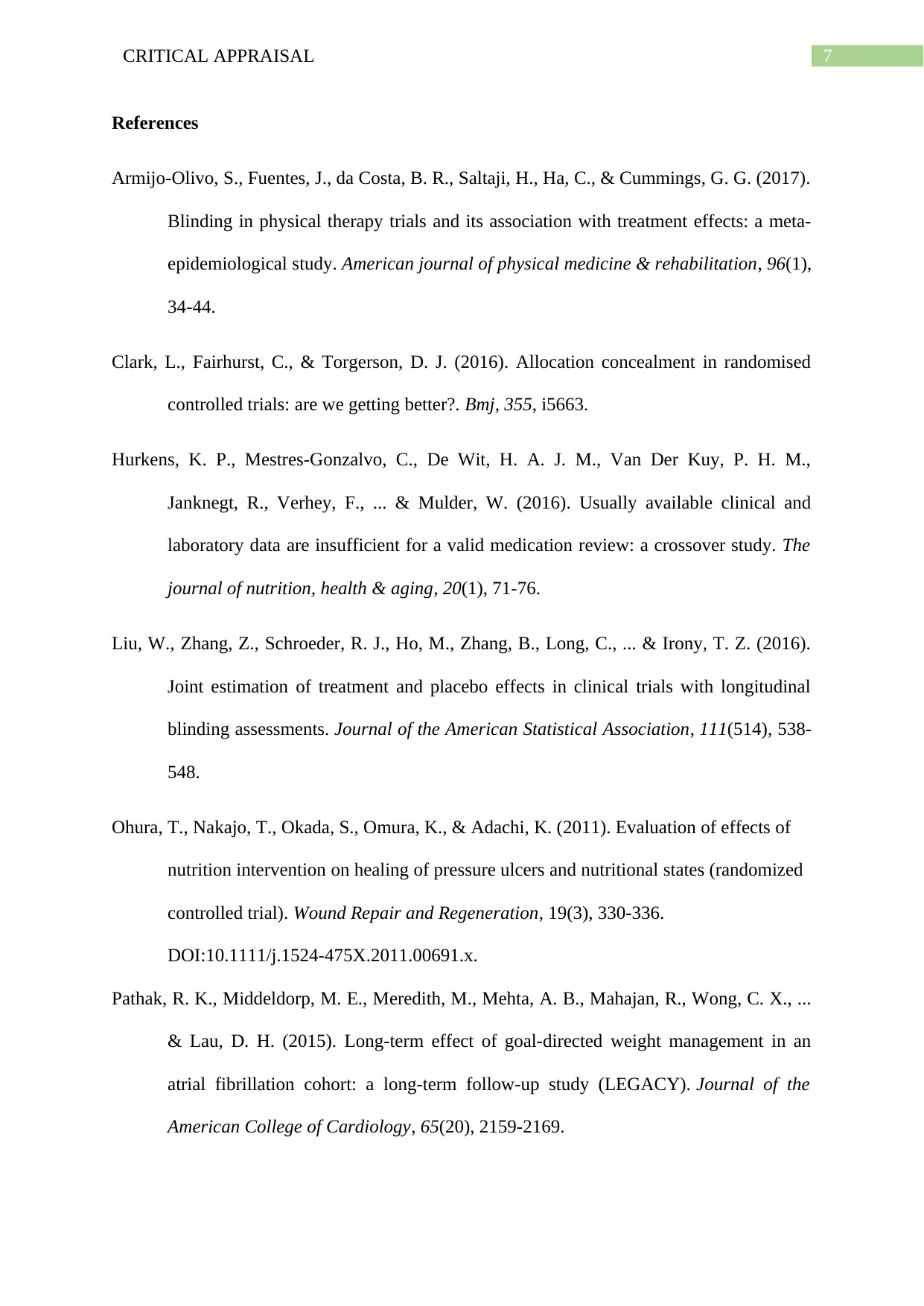
7CRITICAL APPRAISAL
References
Armijo-Olivo, S., Fuentes, J., da Costa, B. R., Saltaji, H., Ha, C., & Cummings, G. G. (2017).
Blinding in physical therapy trials and its association with treatment effects: a meta-
epidemiological study. American journal of physical medicine & rehabilitation, 96(1),
34-44.
Clark, L., Fairhurst, C., & Torgerson, D. J. (2016). Allocation concealment in randomised
controlled trials: are we getting better?. Bmj, 355, i5663.
Hurkens, K. P., Mestres-Gonzalvo, C., De Wit, H. A. J. M., Van Der Kuy, P. H. M.,
Janknegt, R., Verhey, F., ... & Mulder, W. (2016). Usually available clinical and
laboratory data are insufficient for a valid medication review: a crossover study. The
journal of nutrition, health & aging, 20(1), 71-76.
Liu, W., Zhang, Z., Schroeder, R. J., Ho, M., Zhang, B., Long, C., ... & Irony, T. Z. (2016).
Joint estimation of treatment and placebo effects in clinical trials with longitudinal
blinding assessments. Journal of the American Statistical Association, 111(514), 538-
548.
Ohura, T., Nakajo, T., Okada, S., Omura, K., & Adachi, K. (2011). Evaluation of effects of
nutrition intervention on healing of pressure ulcers and nutritional states (randomized
controlled trial). Wound Repair and Regeneration, 19(3), 330-336.
DOI:10.1111/j.1524-475X.2011.00691.x.
Pathak, R. K., Middeldorp, M. E., Meredith, M., Mehta, A. B., Mahajan, R., Wong, C. X., ...
& Lau, D. H. (2015). Long-term effect of goal-directed weight management in an
atrial fibrillation cohort: a long-term follow-up study (LEGACY). Journal of the
American College of Cardiology, 65(20), 2159-2169.
References
Armijo-Olivo, S., Fuentes, J., da Costa, B. R., Saltaji, H., Ha, C., & Cummings, G. G. (2017).
Blinding in physical therapy trials and its association with treatment effects: a meta-
epidemiological study. American journal of physical medicine & rehabilitation, 96(1),
34-44.
Clark, L., Fairhurst, C., & Torgerson, D. J. (2016). Allocation concealment in randomised
controlled trials: are we getting better?. Bmj, 355, i5663.
Hurkens, K. P., Mestres-Gonzalvo, C., De Wit, H. A. J. M., Van Der Kuy, P. H. M.,
Janknegt, R., Verhey, F., ... & Mulder, W. (2016). Usually available clinical and
laboratory data are insufficient for a valid medication review: a crossover study. The
journal of nutrition, health & aging, 20(1), 71-76.
Liu, W., Zhang, Z., Schroeder, R. J., Ho, M., Zhang, B., Long, C., ... & Irony, T. Z. (2016).
Joint estimation of treatment and placebo effects in clinical trials with longitudinal
blinding assessments. Journal of the American Statistical Association, 111(514), 538-
548.
Ohura, T., Nakajo, T., Okada, S., Omura, K., & Adachi, K. (2011). Evaluation of effects of
nutrition intervention on healing of pressure ulcers and nutritional states (randomized
controlled trial). Wound Repair and Regeneration, 19(3), 330-336.
DOI:10.1111/j.1524-475X.2011.00691.x.
Pathak, R. K., Middeldorp, M. E., Meredith, M., Mehta, A. B., Mahajan, R., Wong, C. X., ...
& Lau, D. H. (2015). Long-term effect of goal-directed weight management in an
atrial fibrillation cohort: a long-term follow-up study (LEGACY). Journal of the
American College of Cardiology, 65(20), 2159-2169.

8CRITICAL APPRAISAL
Sanada, H. (2018). ADVANCED ASSESSMENT TOOL FOR PRESSURE ULCERS-
DESIGN-R. World Council of Enterostomal Therapists Journal, 38(2).
Sanada, H. (2018). ADVANCED ASSESSMENT TOOL FOR PRESSURE ULCERS-
DESIGN-R. World Council of Enterostomal Therapists Journal, 38(2).
⊘ This is a preview!⊘
Do you want full access?
Subscribe today to unlock all pages.

Trusted by 1+ million students worldwide
1 out of 9
Related Documents
Your All-in-One AI-Powered Toolkit for Academic Success.
+13062052269
info@desklib.com
Available 24*7 on WhatsApp / Email
![[object Object]](/_next/static/media/star-bottom.7253800d.svg)
Unlock your academic potential
Copyright © 2020–2025 A2Z Services. All Rights Reserved. Developed and managed by ZUCOL.





